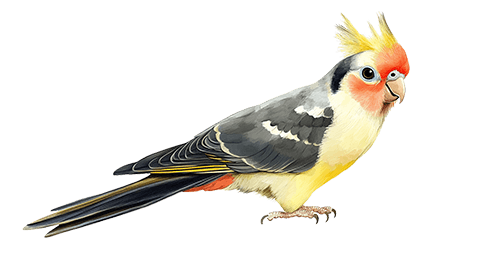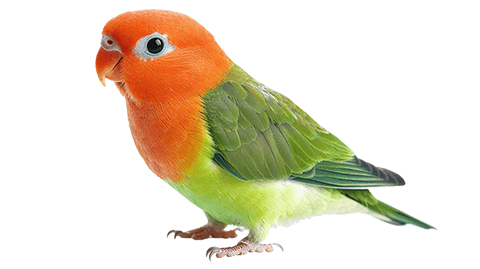Cockatiels: The Whistling Wonders of the Bird World

If you’ve ever heard a bird whistling a happy tune or mimicking a ringtone, there’s a good chance it was a cockatiel. These feathered friends are some of the most charming and social birds you can keep as a pet. Originally hailing from Australia, cockatiels are now one of the most popular pet birds worldwide—and it’s easy to see why! They’re packed with personality, relatively low maintenance, and have a knack for forming deep bonds with their human companions.
What Cockatiels Do
Cockatiels are busy birds! They love to explore their surroundings, play with toys, and engage with their owners. Much of their day is spent preening—they like to stay clean and tidy. You’ll often see them using their beak to comb through their feathers, ensuring everything is in place.
Their vocal talents are another big part of their daily routine. Cockatiels are known for their whistling—some even learn how to whistle entire tunes! Males tend to be the better singers and are often more vocal, while females might be a bit quieter, but this can vary. These birds don’t usually “talk” like parrots, but they’ll surprise you with how many sounds they can imitate, from alarms to video game jingles.

What Cockatiels Like
Cockatiels are big fans of social interaction. They crave attention and don’t do well when left alone for long periods. A cockatiel that’s properly socialized from a young age can become incredibly affectionate—some even enjoy being gently petted or riding around on their owner’s shoulder.
They’re also foodies! Cockatiels enjoy a balanced diet of seeds, pellets, fresh fruits, and veggies. A favorite treat? Millet! Give them a spray of millet, and watch their eyes light up with excitement. But be careful—too many treats can lead to a chubby cockatiel, so moderation is key.

In terms of entertainment, they love toys they can chew, shred, or ring. Foraging toys, where they can work to get a treat, are a big hit. And don’t forget about mirrors—cockatiels are famously curious about their reflections, often “talking” or singing to the bird in the mirror.
Cockatiels & Their Relationship with Humans
One of the reasons cockatiels are so beloved is their ability to form deep, trusting bonds with their human caretakers. They thrive on companionship, and in many cases, a single cockatiel can become very attached to its owner, sometimes to the point where it wants to be near them constantly. This makes them ideal for people who can dedicate time to them each day.
Cockatiels communicate their feelings clearly—when they’re happy, you’ll see them whistling, wagging their tails, or fluffing up their feathers. When upset or frightened, their crest feathers on top of their heads will stand straight up, and they might hiss or even give a warning nip. But once you’ve built trust, they’re gentle and loving companions.

Activity Level
Cockatiels are active and energetic birds. They love to fly and move around, so it’s important to let them out of their cage regularly for some exercise—ideally in a safe, bird-proofed room. If they don’t get enough activity, they can become bored and develop behavioral problems like feather plucking or excessive screaming.
Climbing is another favorite activity. Cockatiels have strong feet and love to grip onto things, like their perches, toys, or even your fingers. If you give them a perch in front of a window, they can spend hours watching the world go by.

Interesting Facts About Cockatiels
- Variety of Colors – While the traditional gray cockatiel with a yellow face and orange cheek patches is the most common, there are several color mutations. Some cockatiels are lutino (a yellow bird with a white face), pied (a mix of yellow and gray), or pearl (a beautiful pattern of white spots on their feathers).
- Lifespan – Cockatiels can live for a long time! With proper care, they can be your companion for 15 to 20 years, sometimes even longer. So, bringing one into your home is a long-term commitment.
- Males vs. Females – Male cockatiels are usually the ones whistling, singing, and showing off. Females can be quieter, but they’re often just as sweet and affectionate. However, females are known to be better at mimicking words, though it’s rare for any cockatiel to develop a big vocabulary.
- Sleep Routine – Cockatiels need their beauty sleep! These birds require 10 to 12 hours of undisturbed sleep each night. A tired cockatiel can be grumpy and less willing to interact, so covering their cage at night helps ensure they get a good night’s rest.
- The Crest – One of the defining features of cockatiels is the crest of feathers on top of their heads. This crest is a mood indicator—when it’s upright, they’re alert or curious; when laid back, they’re relaxed or sleepy. It’s like having a feathered mood ring!

The Bottom Line
Cockatiels are delightful, engaging birds that can bring joy to any home. They thrive on interaction, love to show off their vocal skills, and have unique personalities that can charm just about anyone. Whether you’re a seasoned bird owner or a newbie to feathered friends, cockatiels are a great choice for companionship. Just remember—they’re as much of a commitment as they are cute, so be ready to devote plenty of time, love, and attention to your little whistling wonder!
Further reading: “The Cockatiel Handbook” (Amazon affiliate link) by Mary Gorman.
Affiliate Disclosure
This post may contain affiliate links, which means I earn from purchases made through links. Please see the privacy policy page for more details.







